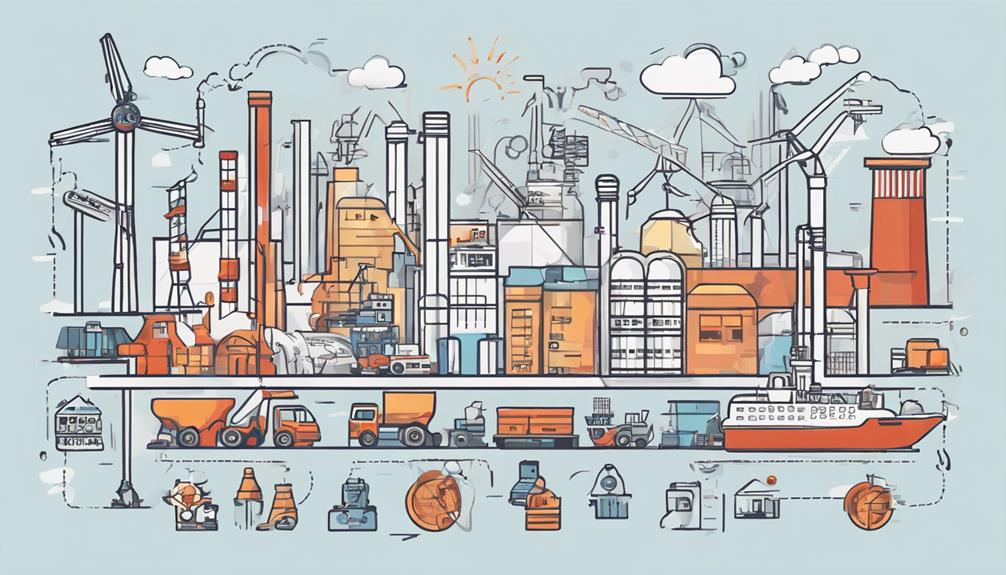An economy serves as the intricate web that governs the production, distribution, and consumption of goods and services within a society. It encapsulates the dynamics of supply and demand, resource allocation, and the interplay of market forces. Yet, beyond these fundamental principles lies a realm where policies, regulations, and unforeseen events come into play, shaping the very fabric of economic systems. Understanding the complexities of what drives an economy unveils a world of strategic decisions, economic theories, and societal impacts waiting to be explored.
Key Takeaways
- Economies govern production, distribution, and consumption of goods and services.
- Different economic systems include market-based, command-based, and mixed systems.
- Economic systems are shaped by resources, culture, laws, history, and geography.
- Market, command, and mixed economies impact resource allocation and economic performance.
Key Takeaways

In examining the intricate workings of the economy, certain key takeaways emerge that illuminate the fundamental principles governing production, distribution, and consumption activities within a society. An economy serves as a system that coordinates the production and consumption of goods and services, efficiently allocating resources within a group. The economy encompasses various types of systems, including market-based, command-based, and mixed systems, each with its unique approach to organizing economic activities. These systems play a crucial role in shaping how resources are utilized, goods are distributed, and services are consumed within a society.
Understanding the economy involves analyzing how different types of economies function based on shared labor and resources. The economy is influenced by a multitude of factors, such as available resources, cultural norms, legal frameworks, historical events, and geographical considerations. By studying these key components, individuals can gain insights into how economies operate and evolve over time, leading to a better understanding of the complex interactions that drive economic activities within a society.
Understanding Economies
Continuing our exploration of economic systems, the study of understanding economies delves into the intricate mechanisms that govern resource allocation, production, and consumption activities within societal frameworks. In an economy, goods and services are produced and distributed through various mechanisms like market dynamics and government regulations. The table below illustrates key aspects of market and command economies:
| Aspect | Market Economy | Command Economy |
|---|---|---|
| Decision-Making | Decentralized, based on consumer demand | Centralized, determined by government directives |
| Resource Allocation | Driven by supply and demand forces | Planned allocation by government authorities |
| Role of Government | Limited intervention, focused on regulation and market stability | Extensive control, ownership of key industries |
Understanding economies involves recognizing how supply and demand dynamics, as well as government interventions, influence the production and distribution of goods and services. Market economies rely on the interaction of buyers and sellers to determine prices and allocate resources efficiently, while command economies prioritize central planning and government control. By analyzing these contrasting approaches, individuals can gain insights into the diverse economic systems that shape societies worldwide.
Types of Economies

Different types of economies exist worldwide, primarily categorized as market economies driven by consumer demand and command economies governed by central planning. Mixed economies, blending elements of both systems, are prevalent globally and reflect a balance between individual choice and government intervention. Understanding these distinctions is crucial in analyzing how different economic structures impact resource allocation, production decisions, and overall economic performance.
Market Vs Command
Within the realm of economic systems, the dichotomy between market and command economies serves as a fundamental distinction shaping the functioning and outcomes of nations' economic activities. Market economies operate based on the laws of supply and demand, responding to consumer preferences and market forces. In contrast, command economies are centrally regulated by government authorities, dictating production and distribution. While most economies in the world today are mixed, blending aspects of both systems, the balance between government intervention and market mechanisms varies widely. China's transition from a command economy to a model promoting private enterprise in 1978 exemplifies the impact of such shifts on economic growth. Economic systems are complex entities influenced by diverse factors such as available resources, cultural norms, legal frameworks, historical contexts, and geographical considerations, which collectively shape their structure and operation.
Mixed Economies
In modern economic landscapes, mixed economies represent a strategic amalgamation of market-driven principles and selective governmental oversight to optimize resource allocation and socio-economic outcomes. These economies, exemplified by countries like the United States and Germany, blend market forces with government intervention to achieve a balance between economic efficiency and social welfare. In a mixed economy, the government plays a crucial role in regulating specific sectors while allowing market mechanisms to function in others. This dual approach aims to ensure fair distribution of resources, promote stable economic growth, and establish social welfare programs for the populace. By leveraging the strengths of both market dynamics and government intervention, mixed economies strive to create a harmonious environment where both private enterprise and public policy work in tandem to achieve overarching economic and social objectives.
Command-Based Economies
Central government control characterizes command-based economies, dictating resource allocation and economic decisions, with examples including North Korea and Cuba. In these economies, the government centrally plans and manages key industries, aiming to achieve social equality and prioritize collective welfare. The table below illustrates key characteristics of command-based economies:
| Characteristics | Description |
|---|---|
| Centralized resource allocation | Resources are allocated by the government based on the state's priorities and goals. |
| State ownership of industries | Key industries are owned and operated by the state, limiting private ownership and competition. |
| Government-determined production | The government decides what goods and services are produced, how they are produced, and for whom. |
Command economies operate on the principle of collective decision-making and control to achieve societal objectives, often at the expense of individual freedoms and market autonomy. Through central planning, these economies seek to regulate production and distribution in a manner that serves the broader social welfare.
Mixed Economies

A fusion of market-driven mechanisms and state-directed interventions characterizes mixed economies, harmonizing individual enterprise with government oversight to optimize resource allocation and economic outcomes. Mixed economies combine elements of market and command economies, aiming to efficiently allocate resources by leveraging the strengths of both systems. In these economies, the government and the market coexist, regulating economic activities while allowing for private enterprise. Countries like the United States exemplify mixed economies, where private businesses operate alongside government regulations. This blending of individual freedom with government control in mixed economies seeks to foster economic growth and stability. Competition, consumer choice, and government oversight are fundamental aspects of mixed economies, addressing diverse needs and priorities within the economic system. By balancing the roles of the market and the state, mixed economies strive to create a framework that maximizes efficiency and welfare for society as a whole.
Studying Economies
The study of economies involves examining fundamental concepts such as economy basics, market analysis, and economic trends. Understanding the intricate workings of these components helps economists and policymakers make informed decisions that shape economic policies and strategies. By analyzing these aspects, researchers can gain valuable insights into the functioning of economies and the factors influencing their growth and stability.
Economy Basics
An essential aspect of understanding the economy involves delving into the fundamental principles of production, consumption, and resource allocation within a society.
- Allocation of Resources: Efficient allocation of resources is crucial for maximizing productivity and economic growth.
- Production and Consumption: The balance between production and consumption drives economic activity and influences overall prosperity.
- Microeconomics and Macroeconomics: The study of individual behavior and economy-wide factors respectively provide insights into how economies function.
Analyzing indicators like Gross Domestic Product (GDP), inflation rates, unemployment reports, and balance of trade offers a comprehensive view of economic health. By examining these factors, economists and policymakers can better understand the complexities of economies and make informed decisions to foster sustainable growth.
Market Analysis
Market analysis in economics involves examining individual behaviors and choices that influence the broader economic system's dynamics. Macroeconomics plays a crucial role in market analysis by focusing on key indicators such as Gross Domestic Product (GDP), inflation, unemployment, and consumer spending to assess economic performance. GDP serves as a fundamental metric in market analysis, representing the total value of goods and services produced within an economy. Unemployment data tracks changes in job availability, offering insights into the labor market's health. Inflation, measured through indicators like the Consumer Price Index, is essential for understanding the economy's stability. By analyzing these macroeconomic factors, economists can gain a comprehensive understanding of the current state of an economy and make informed predictions about future trends.
Economic Trends
Studying economic trends provides valuable insights into the evolving dynamics of economies at both local and global levels.
- GDP: Gross Domestic Product serves as a key indicator, measuring the total value of goods and services produced within an economy, offering a snapshot of its overall health.
- Unemployment: Tracking changes in the number of people working over time helps gauge economic stability and the availability of job opportunities.
- Inflation: Monitoring inflation through indicators like the Consumer Price Index is crucial to understanding the purchasing power of consumers and the overall cost of living.
Analyzing economic trends allows policymakers, businesses, and individuals to make informed decisions, anticipate changes, and implement strategies that can positively impact economic outcomes.
Microeconomics
A fundamental aspect of economic analysis, microeconomics delves into the behaviors and interactions of individual economic agents within markets. It focuses on how individuals, as consumers and producers, make decisions regarding resource allocation and consumption. Microeconomics studies various factors such as pricing mechanisms, market equilibrium, and consumer behavior to understand the dynamics of individual decision-making and its broader implications on the economy.
| Microeconomics | Key Concepts |
|---|---|
| Consumers | Consumer behavior |
| Producers | Production costs |
| Markets | Supply and demand dynamics |
| Resource Allocation | Efficiency and equity |
Key concepts in microeconomics include the foundational principles of supply and demand, different market structures like monopolies and perfect competition, as well as utility theory to explain consumer preferences. By analyzing how individual choices within markets influence overall economic outcomes, microeconomics provides valuable insights into the functioning of economies at a granular level.
Macroeconomics

The holistic study of macroeconomics delves into analyzing and understanding the interconnected economic factors that shape the overall performance and stability of a nation's economy. Macroeconomics focuses on economy-wide indicators such as Gross Domestic Product (GDP), unemployment rates, and inflation levels to provide a comprehensive view of the economic landscape. Through the lens of macroeconomics, policymakers can gain vital insights into the health of an economy and make informed decisions regarding fiscal and monetary policies. Here are three key aspects that underscore the significance of macroeconomics:
- Economic Indicators: Macroeconomics relies on indicators like GDP and unemployment rates to assess the overall economic health of a nation.
- Fiscal Policies: Understanding macroeconomics is crucial for policymakers to formulate effective fiscal policies that can influence economic activity and growth.
- Monetary Policies: Macroeconomics plays a crucial role in guiding the implementation of monetary policies aimed at regulating factors like inflation and interest rates for economic stability.
Economic Indicators
Macroeconomics' exploration of Economic Indicators provides a detailed assessment of a nation's economic health through metrics such as Gross Domestic Product (GDP) and unemployment rates. GDP serves as a fundamental indicator, measuring the total value of goods and services produced within an economy. For instance, the 2023 U.S. GDP reached $26.5 trillion, reflecting the country's economic output. Unemployment reports play a crucial role in tracking changes in employment levels over time, offering insights into the labor market and broader economic conditions.
Inflation and deflation, measured through indicators like the Consumer Price Index, indicate shifts in purchasing power and overall price levels. Additionally, the balance of trade compares a nation's spending on imports to its earnings from exports, influencing economic performance and trade dynamics on a global scale. These economic indicators, including GDP, unemployment reports, inflation, deflation, and balance of trade, are essential tools in macroeconomics for monitoring and analyzing a country's economic well-being.
Gross Domestic Product (GDP)

Exploring the fundamental concept of Gross Domestic Product (GDP) provides a comprehensive insight into a country's economic performance and overall financial well-being. GDP measures the total value of goods and services produced within a country's borders and is a key indicator of economic health. The U.S. GDP, reaching $26.5 trillion in 2023, reflects the size and strength of the American economy. GDP encompasses various components such as consumer spending, government expenditures, investments, and net exports, offering a holistic view of economic activity.
- Government Expenditures: A significant component of GDP, government spending contributes to economic growth by funding public services and infrastructure projects.
- Economic Activity: GDP serves as a barometer of a nation's economic activity, illustrating the level of production and consumption occurring within its borders.
- GDP Growth Rates: Changes in GDP growth rates signal economic expansions or contractions, impacting policy decisions and investor confidence. Understanding these fluctuations is crucial for assessing an economy's trajectory and stability.
Unemployment
Unemployment is a vital economic indicator that reflects the job market trends and has profound implications on society as a whole. The current global unemployment rate of approximately 6.1% in 2021 highlights the number of individuals actively searching for employment opportunities. Understanding the various forms of unemployment, such as structural and cyclical, can provide insights into the complexities of labor markets and their impact on economies worldwide.
Job Market Trends
What factors contribute to the stability of the job market amidst fluctuating economic conditions?
- The U.S. unemployment rate was 3.8% in February 2023, reflecting a stable job market.
- Jobless claims in the U.S. fell to a 52-year low in March 2023, indicating strong employment trends.
- The healthcare and technology sectors showed significant job growth in 2022, offering diverse employment opportunities.
Impact on Society
The ramifications of high unemployment rates extend beyond individual financial constraints to encompass broader economic and societal implications. When unemployment rates rise, there is a direct impact on the job market, economic growth, and the consumption of goods. High unemployment can lead to reduced consumer spending, which in turn can hinder economic growth. This reduction in spending can further exacerbate the unemployment rate, creating a cyclical effect. Moreover, social challenges such as increased poverty levels and mental health issues often accompany high unemployment rates. Addressing unemployment is crucial not only for the well-being of individuals but also for the overall stability and prosperity of society. Understanding the various types of unemployment, like structural and cyclical, is essential in devising effective strategies to combat this issue.
Inflation and Deflation

In economic theory, the interplay between inflation and deflation plays a pivotal role in shaping the stability and growth of an economy.
- Inflation refers to the general increase in prices of goods and services over time, reducing the purchasing power of money.
- Deflation is the opposite of inflation, characterized by a general decrease in prices of goods and services, leading to an increase in the purchasing power of money.
- Inflation is measured by indicators like the Consumer Price Index (CPI), which tracks changes in the cost of a basket of goods and services over time.
Both inflation and deflation are crucial economic indicators that policymakers monitor to maintain price stability and ensure sustainable economic growth. Deflation can have negative impacts on the economy, such as reducing consumer spending, increasing debt burdens, and causing businesses to cut prices and wages. Understanding the dynamics of inflation and deflation is essential for making informed decisions in economic policy and financial planning.
Frequently Asked Questions
What Is a Simple Definition of Economy?
In essence, an economy can be defined as the intricate web of basic concepts and fundamental principles that govern the production, distribution, and consumption of goods and services within a specific region. It encompasses economic systems, market dynamics, and financial interactions that collectively shape the wealth and resources of a society. Understanding the simple definition of an economy is crucial for comprehending resource allocation, job creation, and overall economic development on a broader scale.
What Is Simple Definition of Simple Economy?
In the realm of basic transactions, resource allocation, supply and demand, production distribution, and market exchange, a simple economy represents a fundamental system of economic activities within a confined community or group. These economies often rely on rudimentary trade mechanisms like bartering. They lack the complexity of advanced financial institutions and operate based on informal agreements. Such economies typically lack specialization and employ straightforward methods for allocating resources.
What Is Economies in Simple Words?
Economies, in simple terms, represent the systems that govern the production, distribution, and consumption of goods and services within a society. Basic concepts include resource management, allocation, and decision-making related to economic activities. Key components involve interactions among individuals and businesses in buying, selling, and trading. Real-life examples include market transactions and government interventions. Understanding economies is crucial as they impact employment, prices, and living standards. Common misconceptions may arise around economic complexities and oversimplifications.
What Is an Example of an Economy?
An example of an economy can be observed in the intricate network of trade within ancient civilizations, where barter systems and market exchanges facilitated resource allocation based on supply and demand dynamics. These historical economies relied on trade networks to sustain their societies, showcasing the fundamental principles of economic interactions. Such systems laid the foundation for modern economic frameworks and continue to influence global market dynamics today.
Conclusion
In conclusion, economies are complex systems that involve production, consumption, and resource allocation. They can be market-based, command-based, or a mix of both. Economic indicators such as GDP, unemployment, and inflation provide insight into economic performance. Understanding the intricacies of economies is crucial for policymakers, businesses, and individuals alike. As the threads of supply and demand weave through the fabric of economies, they create a tapestry of interconnected relationships that shape the world around us.
